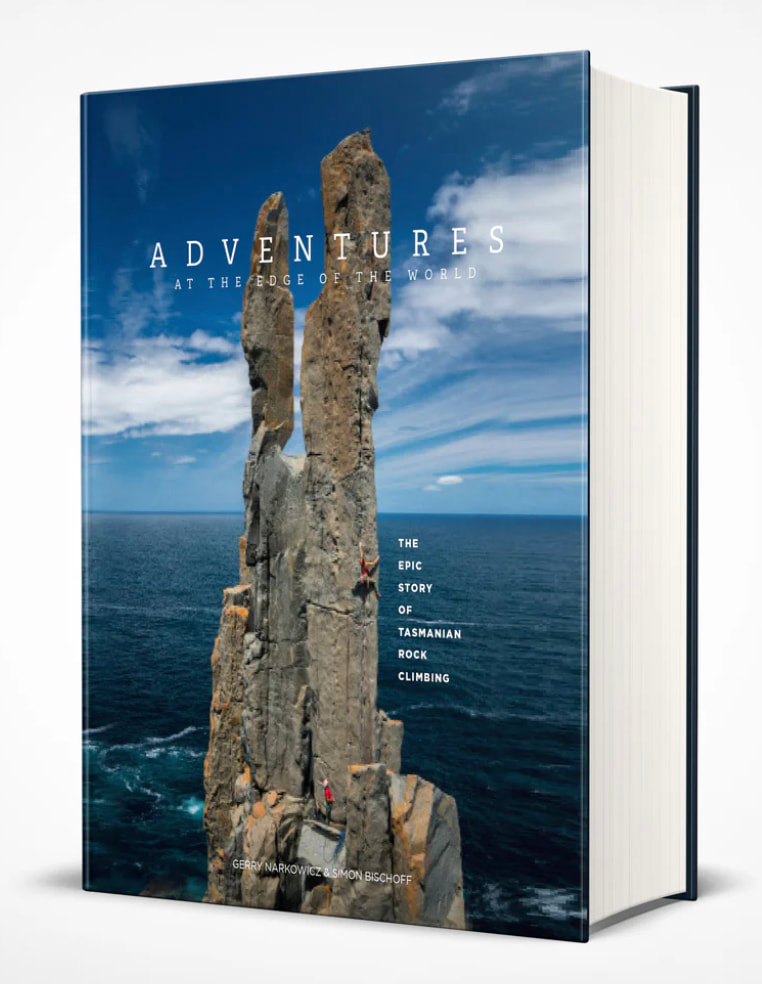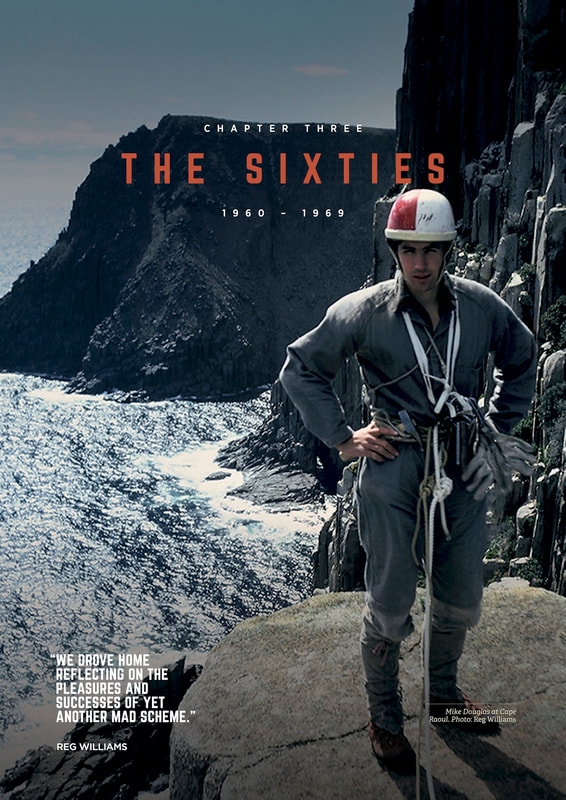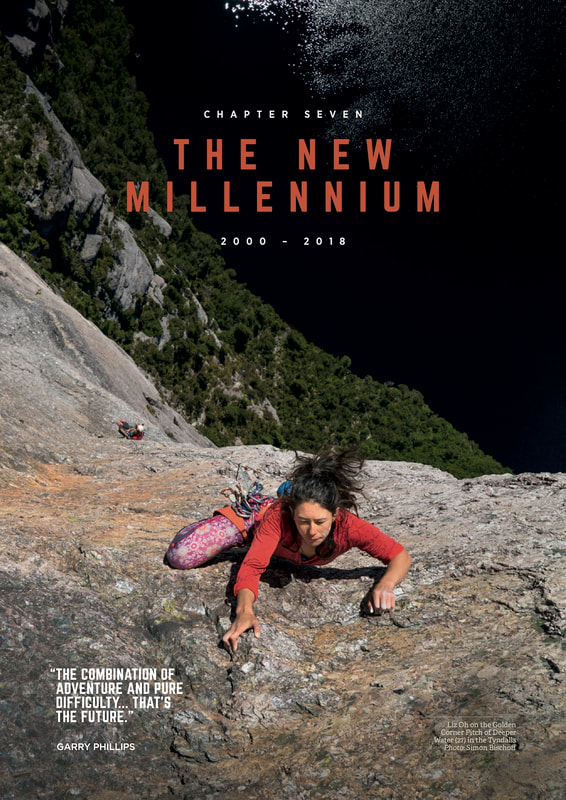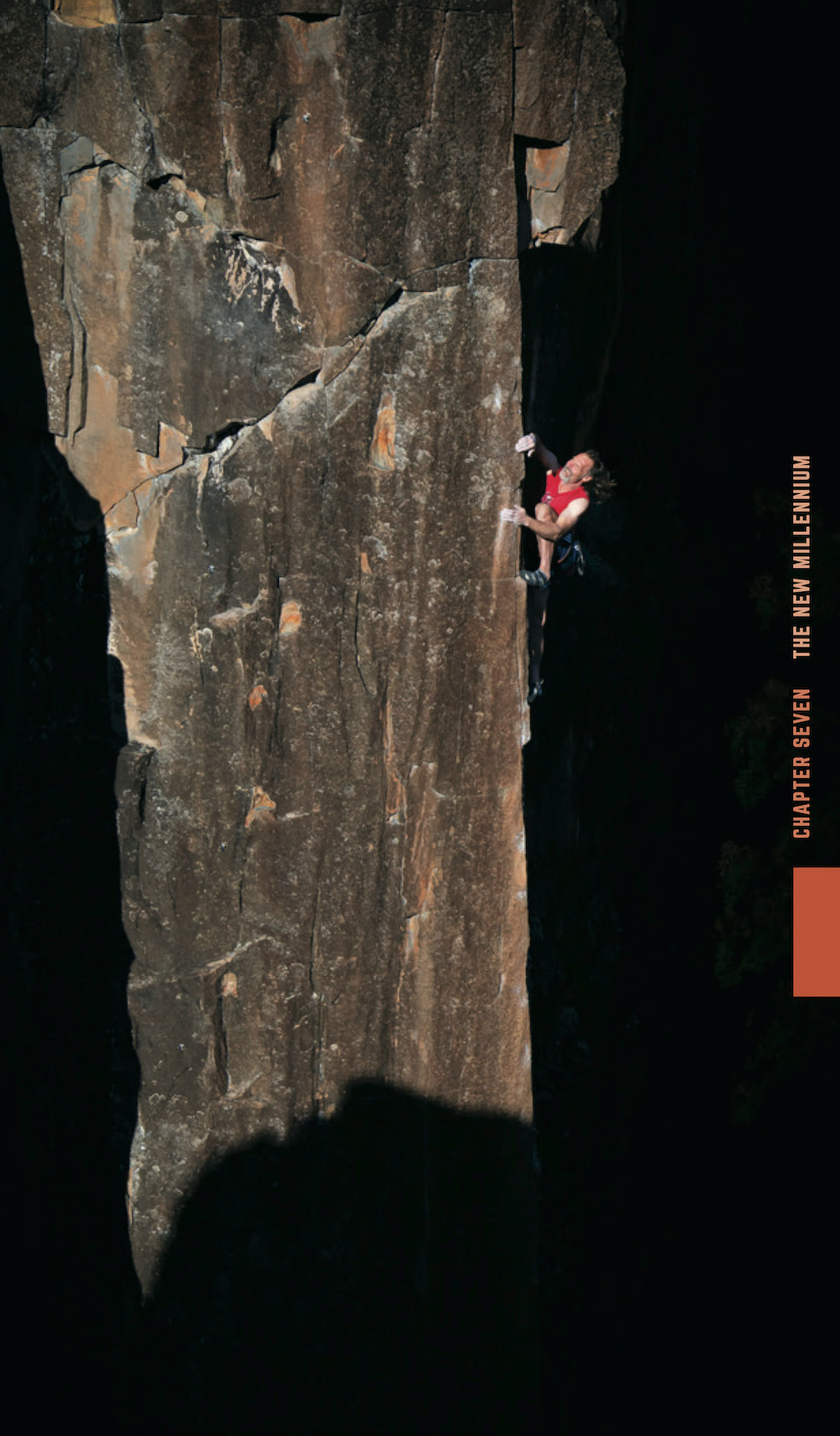“Tasmania. There aren’t many places in the world where you have to jump into a chasm boiling with surf just to access a climb.”
- Gerry Narkowicz
- Gerry Narkowicz
Gerry Narkowicz wrote this and a hundred other quotable sentences in his just released, Climbing Wild. It is a remarkable history of climbing in the Australian state that was once called, Van Deimen's Land.
It will take me a while to unpack what this book documents and questions - and what it means to climbers now as well as those yet to don that rack and head into the hills seeking adventure.
Yesterday I was returning to Hobart, Tasmania’s capital, from a job. It was the golden hour and Mount Wellington (Kunanyi) was in shadow, but haloed in light. I was thinking of this review and at that moment I got exactly what Climbing Wild said. This place, is a wild place. Our mountains and the people that climb them are a story so entwined that they are knotted in nature, history, and culture. This book is their story.
Climbing Wild is an abbreviated history of Gerry’s classic pictorial thesis, Adventures at the End of the World (which is currently sold out.)
Adventures at the End of the World is a colossus book, weighing in at over a kilogram (just over two pounds). It consists of history coupled with extensive essays and climbing portraits of past and present climbers who have contributed to the Tasmanian climbing scene since its beginnings in 1914. What makes Climbing Wild different is Gerry focusing on sequential history, connecting stories with music of those times, highlighting identities that shaped the eras, marking key moments of the climbing endeavour, and updating history with recent developments.
It will take me a while to unpack what this book documents and questions - and what it means to climbers now as well as those yet to don that rack and head into the hills seeking adventure.
Yesterday I was returning to Hobart, Tasmania’s capital, from a job. It was the golden hour and Mount Wellington (Kunanyi) was in shadow, but haloed in light. I was thinking of this review and at that moment I got exactly what Climbing Wild said. This place, is a wild place. Our mountains and the people that climb them are a story so entwined that they are knotted in nature, history, and culture. This book is their story.
Climbing Wild is an abbreviated history of Gerry’s classic pictorial thesis, Adventures at the End of the World (which is currently sold out.)
Adventures at the End of the World is a colossus book, weighing in at over a kilogram (just over two pounds). It consists of history coupled with extensive essays and climbing portraits of past and present climbers who have contributed to the Tasmanian climbing scene since its beginnings in 1914. What makes Climbing Wild different is Gerry focusing on sequential history, connecting stories with music of those times, highlighting identities that shaped the eras, marking key moments of the climbing endeavour, and updating history with recent developments.
Gerry also provides a glimpse of the future of climbing on the Island. It knocks out some of the fluff but ensures the reader gets a true vibe of each age of climbing development. He has worked carefully to link it with first person quotes and each one is brimming with froth.
Delving into its pages, it feels like you are resting by a campfire, the author with a brew, the fire glistening off of his eyes, sharing what seems a malt-whisky-breath of wisdom for the future. It’s like Gerry has reflected on all he has experienced and learnt, expressing some humility in the telling.
Climbing Wild allows Edge of the World to be something that can sit safely on your bookshelf without breaking it - something to be savored and passed down. In contrast, this new book can fit in your daypack and be read on the way to school or to work - history is now more accessible and reasonably priced.
A key theme of this book is found in the title. Climbing in Tasmania is indeed a wild experience. It’s the wild that Gerry wants the reader to focus on - with a roaring ocean surrounding it, a deep and foreboding wilderness within, and the mountains a the spine of that beast.
Wild is not just in the environment we are climbing in down here, it is within the climbers themselves. It takes a certain dash of crazy to walk 30 or more kilometres into the wilderness to then climb a 300-meter peak. Or, to jump from lands’ end into a cauldron of whitewash to access a climb. There is no chalet or Mountain View Hotel to retreat too and sooth a rattled mind after being shaken to the core on many of the routes mentioned in the text.
Those who wander up the climbs of Tasmania are regularly forced by nature to listen and respond to their inner beasts - or have their reckoning with fear and exposure and find their measure. Tasmania’s climbing history is full of these folks. You will learn of their Joe-Brown-type courage and of course, reflect if you have that too.
Delving into its pages, it feels like you are resting by a campfire, the author with a brew, the fire glistening off of his eyes, sharing what seems a malt-whisky-breath of wisdom for the future. It’s like Gerry has reflected on all he has experienced and learnt, expressing some humility in the telling.
Climbing Wild allows Edge of the World to be something that can sit safely on your bookshelf without breaking it - something to be savored and passed down. In contrast, this new book can fit in your daypack and be read on the way to school or to work - history is now more accessible and reasonably priced.
A key theme of this book is found in the title. Climbing in Tasmania is indeed a wild experience. It’s the wild that Gerry wants the reader to focus on - with a roaring ocean surrounding it, a deep and foreboding wilderness within, and the mountains a the spine of that beast.
Wild is not just in the environment we are climbing in down here, it is within the climbers themselves. It takes a certain dash of crazy to walk 30 or more kilometres into the wilderness to then climb a 300-meter peak. Or, to jump from lands’ end into a cauldron of whitewash to access a climb. There is no chalet or Mountain View Hotel to retreat too and sooth a rattled mind after being shaken to the core on many of the routes mentioned in the text.
Those who wander up the climbs of Tasmania are regularly forced by nature to listen and respond to their inner beasts - or have their reckoning with fear and exposure and find their measure. Tasmania’s climbing history is full of these folks. You will learn of their Joe-Brown-type courage and of course, reflect if you have that too.
(Above: Excerpts from the book Climbing Wild: A History of Rock Climbing in Tasmania)
Taken a step further, climbing photography in Tasmania can be a ridiculous undertaking. Capturing Tasmania's raw beauty is not difficult, but capturing that with a climber battling away high above, well that takes a lion tamer.
Photographer Simon Bischoff has collaborated with Gerry for years and his signature shots fill the pages they feature on. Check page 104 or 124 as a couple of prime examples.
Photographer Simon Bischoff has collaborated with Gerry for years and his signature shots fill the pages they feature on. Check page 104 or 124 as a couple of prime examples.
|
Saying this, there are dozens of photos and photographers throughout the text - from the deep past and the heady present. Gerry has made the work of these photographers compliment the text and gawd. The images scream wild from the pages.Their work expands the appeal of the book.
The last two chapters show that the wild climbers of the past exist in those doing it today. And, the future looks just as crazy. It’s just the corner posts that have changed. Where once you could do as you please, today’s climbers need to take into account environmental concerns, the effect on our climbing sites with respect to global warming, the recognition of Indigenous Country, of ethics, and the way climbers relate with one another in more inclusive terms. Times have changed and will change yet still. Gerry reflects on these changes with respect. I believe it’s a point to make that this book is unique in climbing literature; there are not many that cover an entire territory - an island-state - like Climbing Wild. This book can be used as a reference on how to do that and do it with style. Written by a key climber, a resident of the Island, and a friend to many, Gerry has set a benchmark in Australian (and I believe) global climbing literature. If you want to climb here read Climbing Wild. By doing this you will know whose giant shoulders you are standing upon. It will also provide a compass of a wild of place and the wild within. Come and write your chapter in the story of Tasmanian climbing. May Climbing Wild inspire you as it has me. Post Note: When I was driving over the Tasman Bridge into Hobart that day with the mountain in silhouette and glowing, the song, Hungry Eyes (yes from Dirty Dancing) came on my radio. I laughed and thought of Gerry, looking at the mountains, eyes perched at its crags and ranges, mesmerised by their beauty and their terror - always uncontainable. Tasmania keeps him hungry. That’s the wild he wants us all to experience. |





